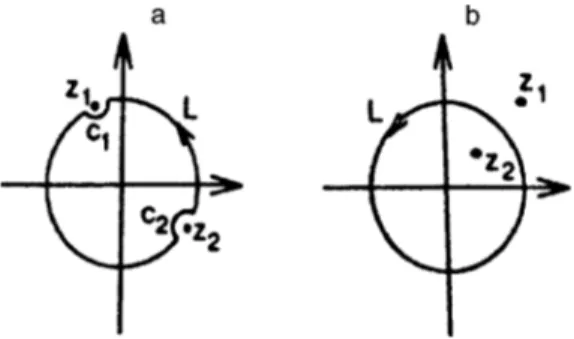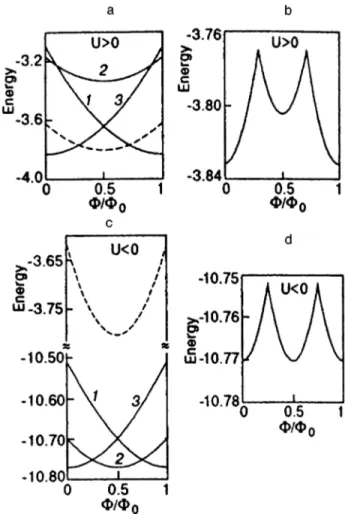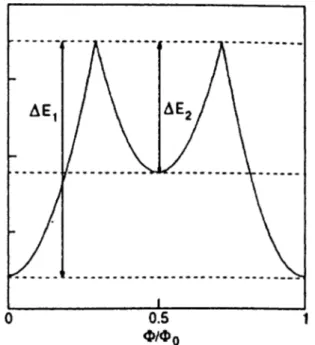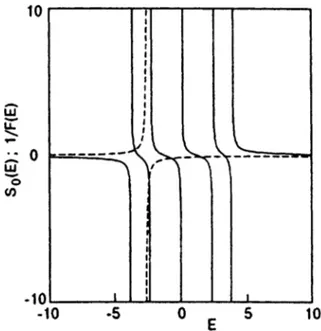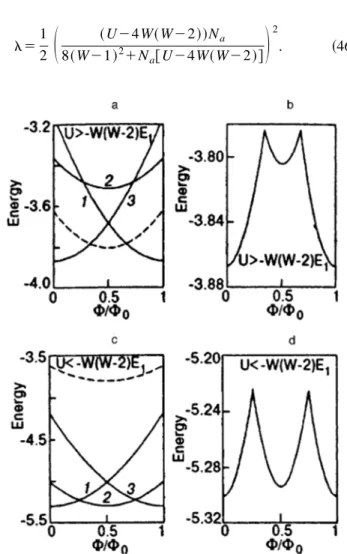Bound electron pairs in strongly correlated models of high-temperature
superconductivity
H. Boyaci, and I. O. Kulik
Citation: Low Temperature Physics 24, 239 (1998); View online: https://doi.org/10.1063/1.593577
View Table of Contents: http://aip.scitation.org/toc/ltp/24/4
Bound electron pairs in strongly correlated models of high-temperature
superconductivity
H. Boyaci and I. O. Kulik*
Department of Physics, Bilkent University, Bilkent, 06533 Ankara, Turkey** ~Submitted August 7, 1997; revised November 17, 1997!
Fiz. Nizk. Temp. 24, 316–325~April 1998!
The ground-state energy of two electrons on a ring is calculated for the one-dimensional Hubbard model with positive and negative on-site interaction and for the contraction model with additive and multiplicative interaction terms. The hc/2e periodicity of the ground-state
energy with respect to a fluxF threading the loop is derived. The periodicity may serve as an indication of superconductivity. The results are shown to be consistent with the Lieb–Wu solution forF50 limit. In addition, the new states that were missing in the Lieb–Wu solution
are derived. © 1998 American Institute of Physics. @S1063-777X~98!00504-0#
1. INTRODUCTION
Among the possible mechanisms of high temperature su-perconductivity attention was focused in the last years on strongly correlated systems,1 non Fermi-liquid scenarios,2,3 magnetic schemes~spin-fluctuation4,5and spin-bag6! and soft orbital mode interaction mechanisms.7,8The generic Hamil-tonian underlying these models are the one-, two-, or three-band Hubbard positive- or negative-U Hamiltonians and contraction Hamiltonians with a hopping amplitude which depends upon the sum or product of the near-site occupation number operators. The criterion for superconductivity can be learned in the pairing instability, in the Meissner effect, or in flux quantization. In this paper some of the above models are considered in an assumption that halving of the flux
period-icity in the energy versus flux dependence
~hc/e to hc/2e! may serve as an indication of the supercon-ducting transition.
The purpose of this paper is to show some new states for the one-dimensional Hubbard model, which are missing in the Lieb–Wu9 solution, and to show that the contraction model may serve as a mechanism for superconductivity. Similar states appear in other strongly correlated models of high-Tc superconductivity. Specifically, we will analyze in
this paper three Hamiltonians for strongly correlated fermi-ons:
~1! Hubbard model with repulsive on-site interaction.5 ~2! Negative-U Hubbard Hamiltonians.27,28
~3! Contraction-pairing mechanisms.7,8,10
It is known that direct O-O hopping in high-Tc super-conductors is important. Since oxygen in oxides like YBa2Cu3O61x has almost filled p-shell configuration, holes in a p6 shell may play a similar role for the conduction in oxides in question, as the electrons from nearly empty atomic shells in conventional metals do. Oxygen atoms are specific in the sense that change of the oxygen ionization state ~O0 to O2 and O22! results in a dramatic increase of
px, pyorbitals in the CuO plane, and therefore in the increase
of the magnitude of hopping between near oxygen ~as well
as near oxygen-copper! sites. A non-s-wave orbital
configuration10 is expected to survive with consideration of this occupation-dependent hopping.
2. GROUND-STATE ENERGY OF TWO ELECTRONS IN THE HUBBARD MODEL WITH POSITIVE AND NEGATIVE ON-SITE INTERACTION
We consider a loop of Na lattice sites with a magnetic
flux F threading the loop ~Fig. 1!. The electrons can hop between neighboring lattice sites, and each site can be occu-pied by at most two electrons with opposite spins. The Hamiltonian for this system has the form
H52t
(
j ,s ~cj,s 1 c j11,seia1cj111,scj ,se2ia! 1U(
j nj↑nj↓, ~1!where c1j ,s and cjs are respectively the creation and
annihi-lation operators of an electron with spin projection sat the
jth lattice site, t is the electron hopping amplitude, a5(2p/Na)(F/F0) ~here F05hc/e is the magnetic flux quantum!, njs is the occupation number operator, and U is on-site interaction term. The energy spectrum of H is
invari-ant under the replacement of t by 2t. Hence, we assume
t511 in appropriate units.
The wave function for two electrons, one with spin up and the other with spin down, is
uC
&
5(
x1,x2 f~x1,x2!cx 1↓ 1 c x2↑ 1 u0&
, ~2!whereu0& is a vacuum state.
The eigenvalue equation HuC
&
5EuC&
leads to 2@~ f~x111, x2!1 f ~x1,x211!!eia1~ f~x121, x2!1 f~x1,x221!!e2ia#1Ud~x1,x2!f ~x1,x2!
5E f~x1,x2! ~3!
or, in the momentum space,
239
~E12 cos~K11a!12 cos~K21a!!fK1,K2
5 U
Na
(
K fK12K,K21K, ~4!
where K1,25(2p/Na)n1,2 with n1,250,1,2,..., Na21. Here fK1,K2 is assumed to satisfy the periodicity condition
fK112p,K25 fK1,K212p5 fK1,K2. Equation~4! can be rewrit-ten as follows: PQ
S
12 U Na 3(
p 1 E12 cos~K12p1a!12 cos~K21p1a!D
50, ~5! where PQ5(1/Na)(KfK12K,K21K, Q5K11K25(2p/Na)n, and p5(2p/Na)m. Hence, either the term inside the parentheses or PQ should be equal to zero.
„I… PQÞ0. The Lieb and Wu solution
For PQÞ0, the term inside the parentheses should be equal to zero, or 1 U5S~E!, ~6! where S~E!5 1 Na
(
p 1 E12 cos~K12p1a!12 cos~K21p1a! . ~7! Using the Poisson summation formula,1 U5n52`
(
`E
0 2p d p 2p exp~ipNan! E14 cos~Q/22p!cos~Q/21a! ~8! S(E) becomes S~E!5(
n52` ` Sn~E